Introduction to Vehicle Telematics
Modern vehicles use advanced connection and information technologies that have made driving more connected and well-informed. Vehicle telematics is the most obvious way that this connection is made possible. As we start this part, we'll go into great detail about telematics, including what it is, how it can be used, and how it has completely changed many aspects of driving.
Definition and Applications
Vehicle telematics is a term that comes from the words "telecommunications" and "informatics." It basically means keeping an eye on a car by using its onboard diagnostics to gather information about its location, speed, idling time, harsh acceleration or braking, fuel consumption, and other things. The information is then sent to a central place, usually via cellular, satellite, or Wi-Fi communications, to be processed, analyzed, and stored.
Vehicle telematics can be used for many different things, such as:
Navigation: Telematics gives you real-time information on where your car is and the best routes to take, taking into account live traffic updates.
Safety: Telematics can find accidents and instantly call the police and fire department, telling them exactly where the accident happened and how bad it might have been.
Entertainment and Information: Telematics systems often have internet connections that let you use video services and get news, weather updates, and other information.
Fleet Management, Emergency Services, Remote Diagnostics
While telematics has brought about big changes in some areas, most notably:
Fleet Management: Companies that own a group of vehicles use telematics to keep track of where the vehicles are, how the drivers are behaving, how much gas they are using, and when they need to be serviced. This makes sure that the best routes are taken, lowers operating costs, and makes driving safer.
Emergency Services: Some telematics systems have automatic crash notification (ACN) features that send an immediate message to emergency services in the event of an accident. This could save lives. Also, emergency services can use these systems to find and get to cars that are having problems more quickly.
Remote Diagnostics: One of the most innovative uses of telematics is the ability to do diagnostics on a car from afar. Telematics can let drivers know right away about maintenance needs, possible problems, or system failures by constantly checking the health of the car. This not only helps keep the car from breaking down but also makes it last longer by making sure it gets regular repairs.
To sum up, vehicle telematics is proof of how cars and computers are becoming more and more alike. As these systems become more commonly used in cars, they offer safer, more efficient, and better-informed trips. In the parts that follow, we'll go into more detail about the vast world of V2X communication and look at how vehicles interact with their surroundings.
Vehicle-to-Everything (V2X) Communication
A key idea in the automotive business is vehicle-to-everything (V2X) communication, which means that cars will be more automated and connected in the future. The name "V2X" comes from the idea that vehicles can talk to more than just each other. They can also talk to other things and systems around them. This part will talk about the different parts of V2X communication and what they mean for traffic flow, road safety, and the transportation environment as a whole.
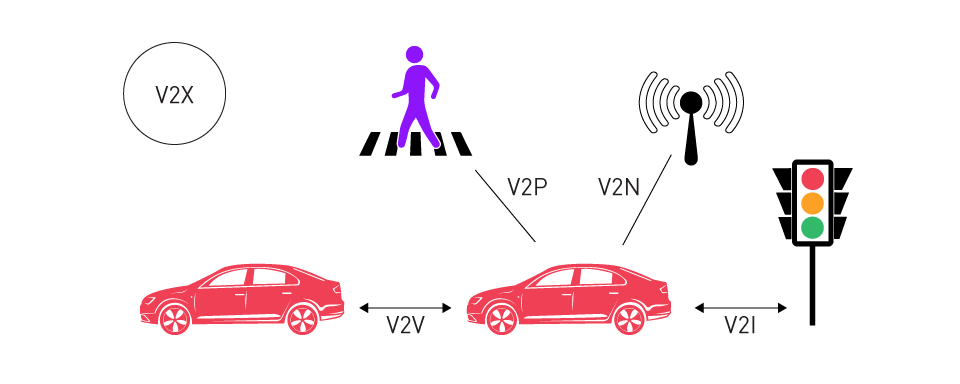
Figure 1: Types of V2X
Vehicle-to-Vehicle (V2V)
Vehicles can talk to each other through V2V contact, which can be done directly or indirectly. This can include information about the vehicle's speed, direction, position, and other telemetry. One of the main goals of V2V is to make driving safer. For example, if a car in front of you quickly stops, it can let the cars behind you know right away, giving them time to react and possibly avoiding a crash.
Vehicles that drive themselves are becoming more common, and V2V makes coordinated maneuvers easier. For example, platooning lets a group of vehicles ride close together to save airflow.
Vehicle-to-Infrastructure (V2I)
Vehicles can talk to things on the road, like traffic lights, road signs, and even toll booths, using V2I contact. As an example, a traffic light could let an approaching car know when it will turn green, which would let the car change its speed to save gas. In addition, real-time V2I communication can let drivers or self-driving cars know about lane closures, roadblocks, or detours in places like building zones.
Vehicle-to-Pedestrian (V2P)
A less talked about but just as important part of V2X is V2P contact, which lets vehicles see and talk to pedestrians, especially those who are wearing smart devices or other wearable tech. For instance, a car could get a signal if a person on foot with a smartphone connected is about to cross the road in front of it, even if the driver can't see the person yet. This feature can greatly lower crashes involving pedestrians, especially in cities.
Vehicle-to-Network (V2N)
Vehicles can join to bigger networks, usually cellular or cloud-based ones, using V2N communication. This kind of connection can be used for many things, such as getting real-time traffic updates and figuring out the best route, as well as diagnosing vehicles remotely and updating software over the air. V2N is basically the foundation for more advanced telematics services, cloud-based analytics, and even the general use of self-driving cars.
In conclusion, V2X communication shows how a connected transportation system works as a whole. As cars become more connected to the Internet of Things (IoT), their ability to talk to other vehicles, infrastructure, and even people walking on the street will be very important in making the transportation ecosystem safer, more efficient, and quicker to respond. In the parts that follow, we'll talk about the technical side of V2X communication, security issues, and possible futures.
Technologies and Protocols for V2X Communication
As the need for Vehicle-to-Everything (V2X) connectivity grows, it is more important than ever to have strong, reliable, and standard technologies and protocols to support it. This part talks about Dedicated Short Range Communications (DSRC) and Cellular V2X (C-V2X), two of the most important technologies that are making V2X the best way for cars to talk to each other.
Dedicated Short Range Communications (DSRC)
DSRC is a type of wireless communication system that was made just for use in cars. DSRC was created in the late 1990s to support high-speed data transfer in places where fast-moving vehicles work. It has some special features, such as:
Latency: DSRC has low latency, usually less than 100 milliseconds, which is important for real-time contact in situations with a lot of traffic.
Reliability: Because DSRC uses a dedicated spectrum (5.9 GHz in the U.S.), it has less interference, which makes the transmission channel more stable.
Range: Its main purpose is for short-range uses (up to about 1 km), but the range is good enough for most V2X situations, such as V2V and V2I.
But DSRC has been criticized for evolving more slowly than cellular technologies, which are changing quickly. Also, it's mostly only used in places like the United States; many other countries have chosen cellular options.
You can use the DSRC radio band for free as long as you have a license. Spectrum is distributed differently around the world, but this was done so that countries like Europe and the USA would be able to work together because the bands would be close enough that the same antenna and transmitter/receiver could be used.

Figure 2: Worldwide Spectrum Allocation for DSRC
Cellular V2X (C-V2X)
C-V2X is a newer, more flexible method for V2X contact that uses cell phone technology. Now that 4G has improved and 5G is starting to roll out, C-V2X has more features than DSRC:
Flexibility: C-V2X can work in more than one band, unlike DSRC, which needs its own spectrum. This lets it connect to current cell phone networks.
Evolution Path: Because it comes from cellular technology, C-V2X is naturally set up to evolve. As cell phone networks move from 4G to 5G and beyond, C-V2X can easily take advantage of these improvements.
Modes of Operation: The C-V2X has two main operating modes: Direct Communication (for V2V, V2I, and V2P situations) and Network Communication (mainly for V2N situations).
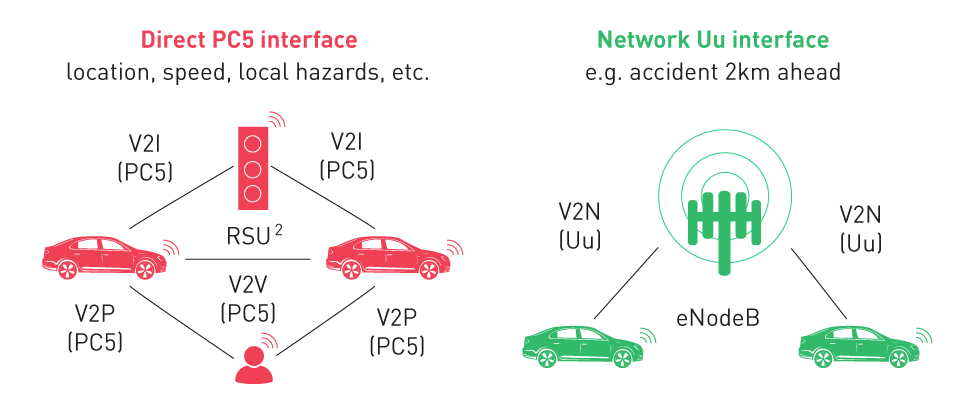
Figure 3: Depiction of the Direct and Network Communication Modes
While DSRC and C-V2X are often seen as competing technologies, it's important to keep in mind that they are actually very different in how they work and how they are designed. DSRC was made for use in vehicles, while C-V2X takes advantage of the wider improvements in cellular technology for V2X situations.
Most of the time, the decision between DSRC and C-V2X comes down to regional preferences, the rules in place, and the V2X applications in question. No matter what technology is used, the main goal is to make sure that vehicles can communicate in a way that is safe, reliable, and in real time in a transportation ecosystem that is becoming more and more linked. In the parts that follow, we'll talk more about security and problems that might arise in the future with V2X communication.
Security and Privacy in Vehicle Connectivity
As cars become more and more connected, it is very important to make sure that the data being sent and received is safe and private. Vehicle-to-Everything (V2X) contact is becoming more common, which makes it even more important to protect these systems from possible threats and keep user data private. We'll talk about some of the most important security and privacy issues when connecting a car in this part.
Data Encryption and Authentication
Data Encryption: When cars talk to each other and to parts of the infrastructure, the data they send must stay private so that it can't be hacked or used in a bad way. Encryption methods turn this information into codes that can only be read by the right people who have the right decryption key. For added security against hackers, advanced encryption standards like AES-256 have been used in vehicle communication networks.
Authentication: Making sure that the communicating entities are real is just as important. This is true for cars, infrastructure parts, and service providers. Devices in a communication network are checked to make sure they are who they say they are, which stops impersonation attempts. Public Key Infrastructure (PKI) is a common method used in V2X systems. Trusted Certificate Authorities (CAs) give digital certificates to communicating nodes to prove their identities.
Privacy Concerns and Data Protection
Location Privacy: Because of how V2X communications work, cars often send out information that can show where they are. If this isn't treated carefully, it could allow bad people to spy on vehicles and invade people's privacy. To make it harder to track vehicles, methods like "mix zones" (places where vehicles change their fake names) are being considered. These zones would change the markers of vehicles on a regular basis. The European Data Protection Directive [EU95] gives more information about location protection.
Personal Data Protection: These days' cars, especially ones with tracking features, collect a lot of personal information, like what the driver likes and where they've been. It is very important to keep this information private and only use it for what it was meant for. Data anonymization and data minimization are two important ways to protect user privacy. Data anonymization removes personal information from data sets, and data minimization only collects the data that is needed. A number of security and privacy standards are also being worked on. These include the American IEEE 1609.2 security standard and the European ETSI V2X security standard.
Regulatory Compliance: As worries about data privacy grow around the world, strict rules like the General Data Protection Regulation (GDPR) in Europe have been put in place to govern how personal data should be treated. Automakers and service providers need to make sure that their systems and methods are in line with these rules to avoid big fines and keep users' trust.
Basically, security and privacy can't be afterthoughts as cars keep moving toward becoming mobile data hubs. They need to be built into the very core of these systems to ensure not only the safety of the vehicle and its occupants but also the trust and faith of everyone who uses this ecosystem. In the next parts, we'll talk about what the future holds for connected vehicles and how they will work with new technologies.
Future Trends and Challenges in Vehicle Connectivity
As the transportation world changes quickly, new trends appear and tools get better at working together. This last part on vehicle connection looks at the future directions of the field and the problems that need to be solved before we can have fully connected and self-driving cars.
5G and Beyond for V2X Communication
High Bandwidth and Low Latency: 5G, the fifth-generation technology standard for cellular networks, offers very fast data transfers of up to 20 Gbps with very little latency, just a few microseconds. For V2X transmission, this means that cars can send and receive huge amounts of data very quickly. This feature is very important for making decisions in real time, especially when there is a lot of traffic or an emergency. With V2X, cars will be able to "see" around turns. Drivers will no longer want to speed through red lights to get ahead. It might even be possible to cut down on the number of stoplights, stop signs, and cars stopping in general if standards like 5G are used well. All of these are very good things that will make things safer.
Network Slicing: One of the best things about 5G is that it lets you make custom "slices" of the network that are only used for certain things. For interactions between vehicles, a dedicated slice makes sure that important vehicle data gets sent first, which lowers the chance of communication problems or delays.
Beyond 5G: As work on 6G and other generations after it picks up speed, the future looks bright for even more advanced ways to link. Integrated terrestrial and non-terrestrial networks are ideas that point to a future where cars could easily talk to satellites, drones, and systems on the ground all at the same time.
Integration with Autonomous Driving Systems
Sensor Fusion and V2X Synergy: LiDAR, radar, and cameras are just a few of the sensors that autonomous cars use to understand their surroundings. V2X communication adds another level of awareness by letting the vehicle "see" beyond the range of its sensors. For example, it can "see" a vehicle coming quickly around a blind corner. Another example is a front vehicle that can "see" the scene that the vehicle behind it can't and share the information it has gathered, such as the lanes, traffic signs, and obstacles.
Dynamic Decision Making: With V2X, self-driving cars can make better choices by thinking about what other people on the road are trying to do. For example, a self-driving car could let another car in front of it that wants to merge into its lane. This would make traffic run more smoothly.
Challenges in Standardization and Integration: It's not easy to combine V2X transmission with systems that run themselves. To make sure that cars from different brands can talk to each other easily, world standardization is needed. Adding V2X info to the algorithms that self-driving cars use to make decisions also needs a lot of testing to make sure it is safe and reliable. Several groups work together to develop and standardize C-V2X technology. These include the 3rd Generation Partnership Project (3GPP), the European Telecommunications Standards Institute (ETSI), the Institute of Electrical and Electronics Engineers (IEEE), and the 5G Automotive Associations.
Ethical Considerations: When V2X and liberty come together, they create ethical problems. It looks like an accident is about to happen. How does the car decide what to do when both its onboard sensors and V2X data are being considered? Such choices could put the safety of the people inside the car, other drivers, or even walkers ahead of other people.
To sum up, the future of vehicle connectivity is one of more complicated and integrated systems. As we move toward a future with smart cities and self-driving cars, advanced connectivity plays an increasingly important part. There are many problems to solve, but if we keep researching and working together around the world, a future with connected and self-driving cars seems not only possible but also inevitable. In the next parts, we'll talk more about the complex design issues and new ideas that are driving this revolution.


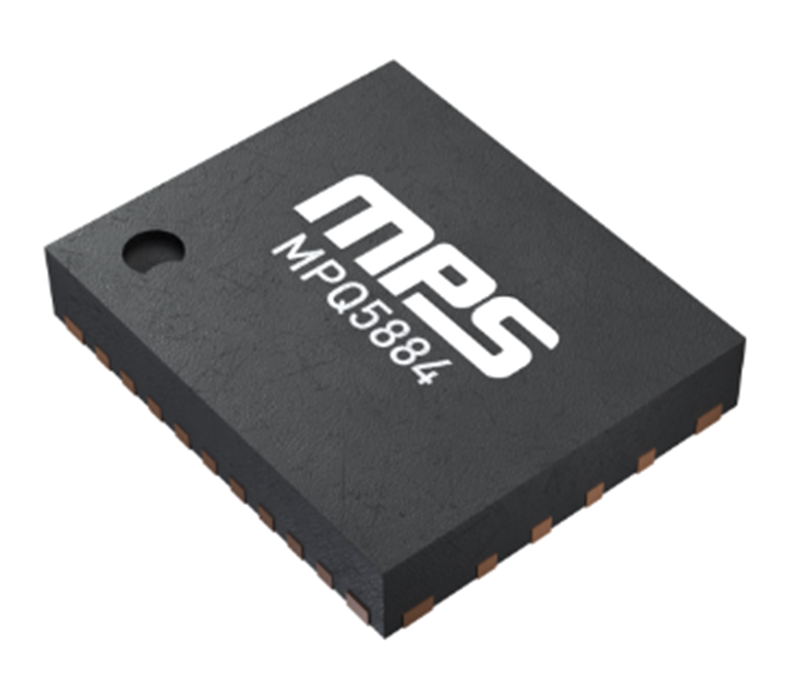

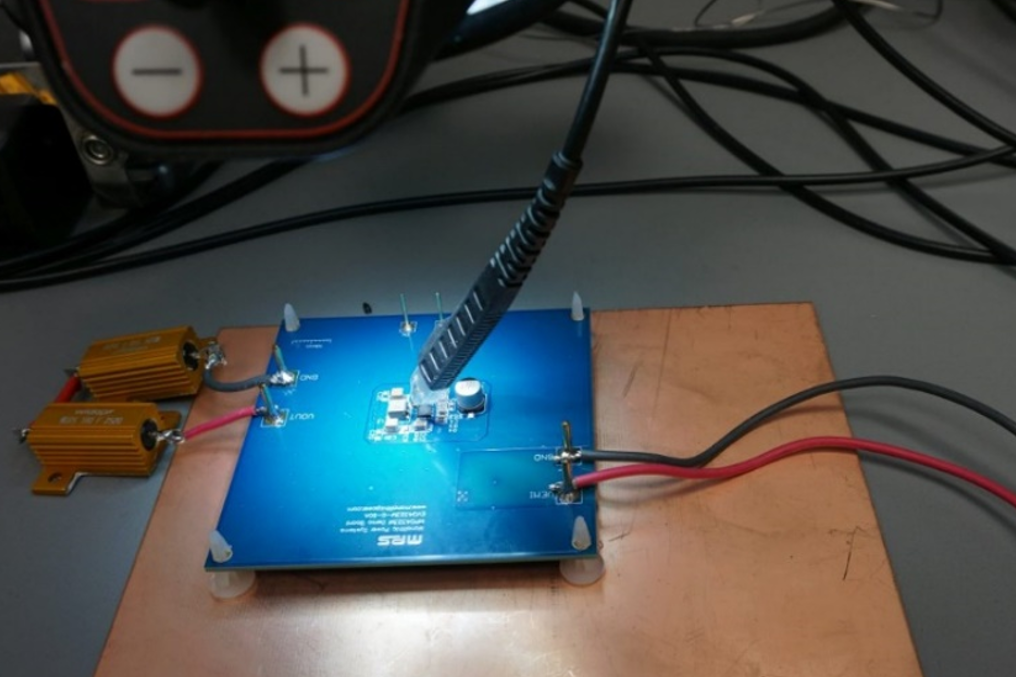
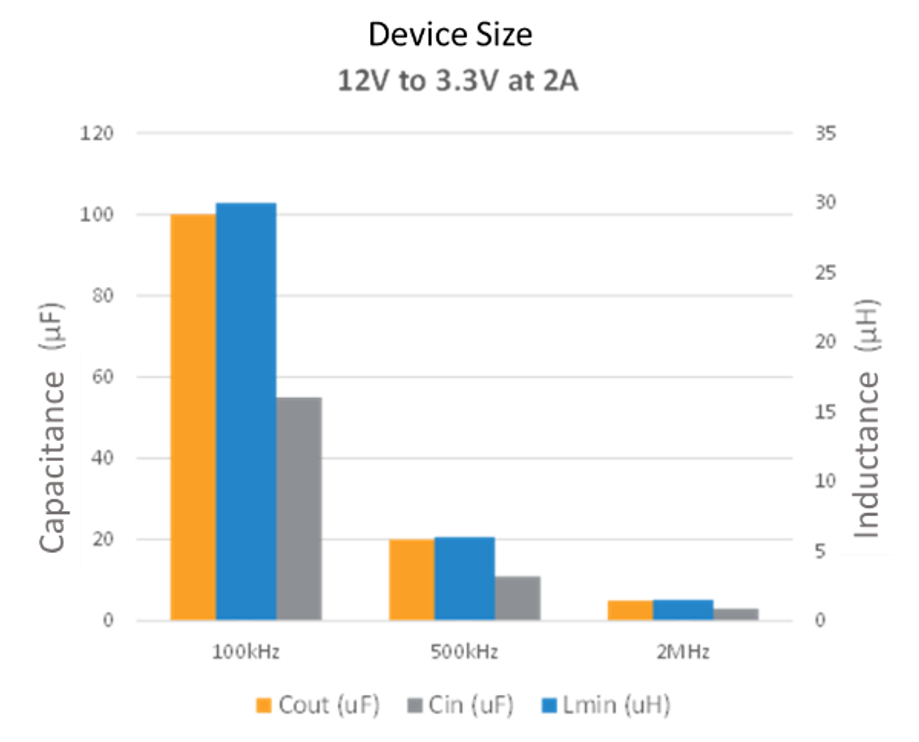

直接登录
创建新帐号